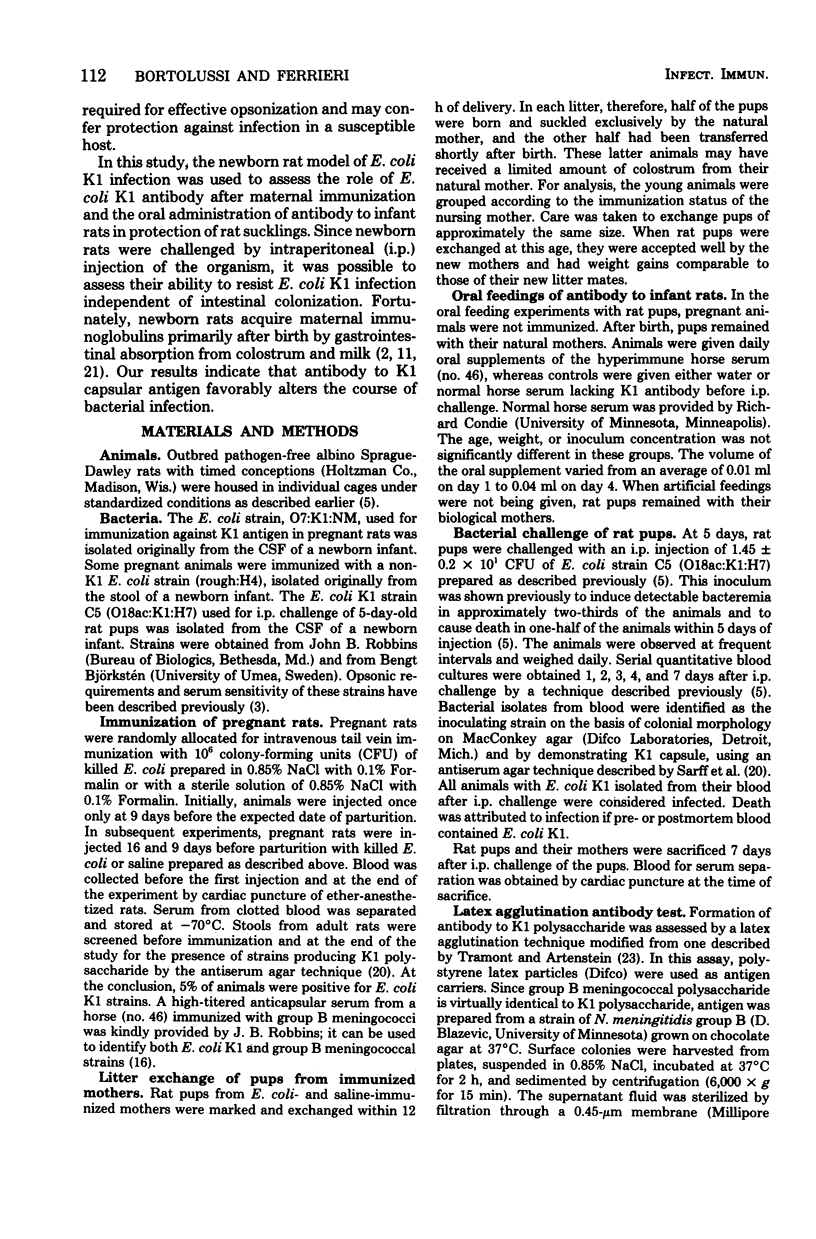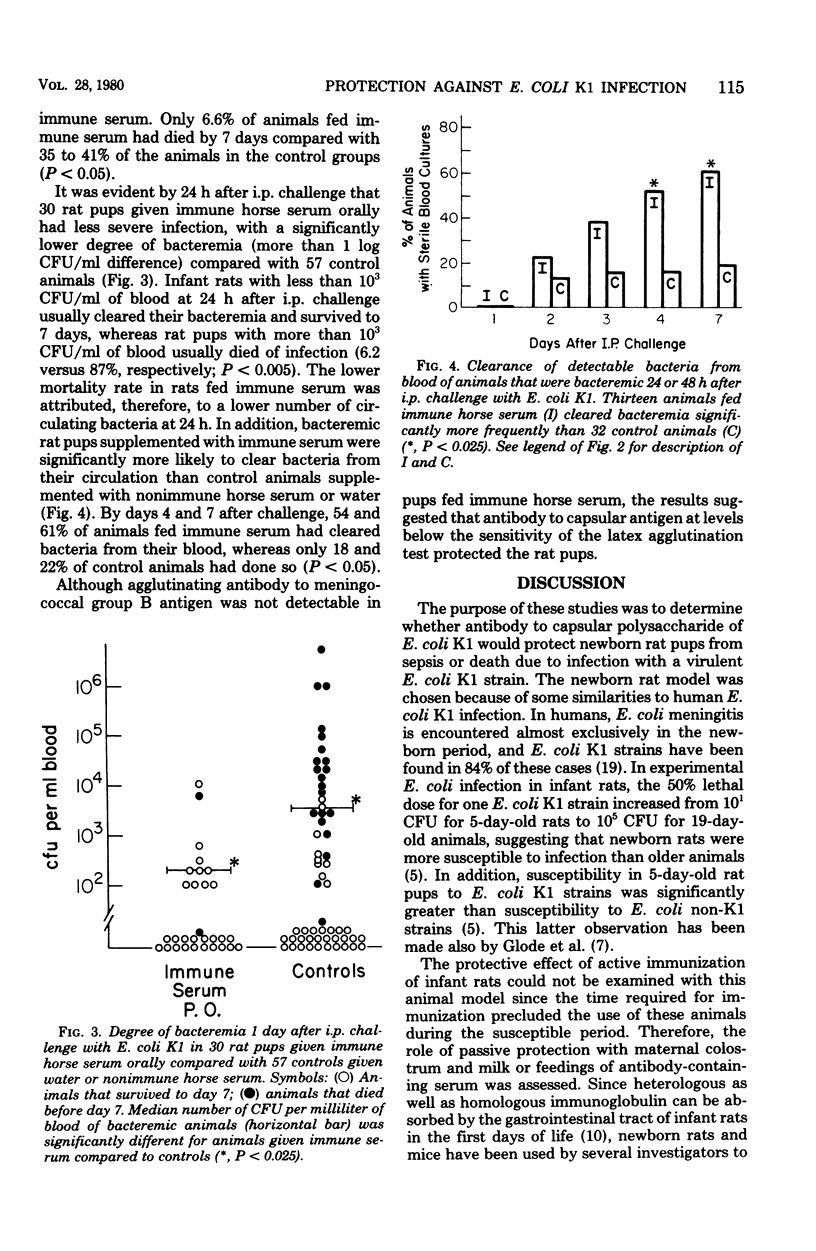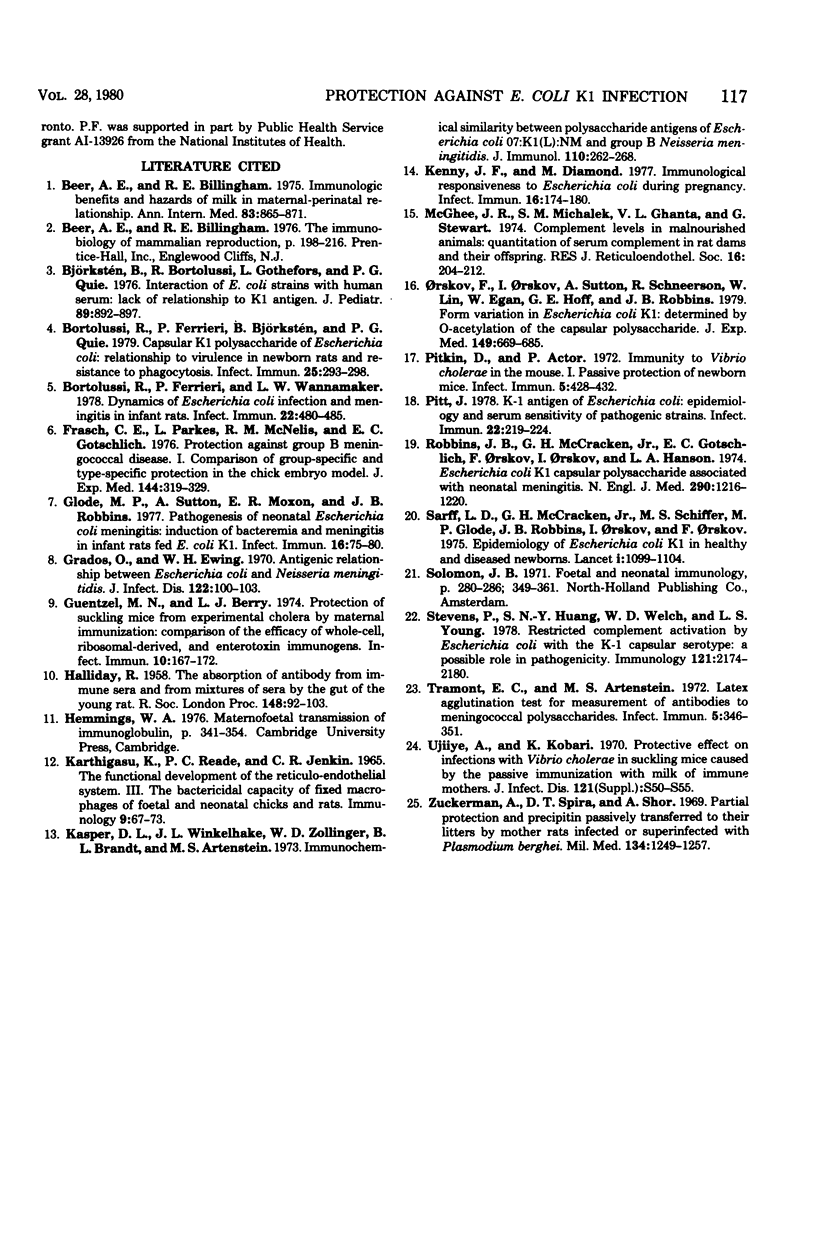Abstract
The protective value of antibody to the K1 capsular polysaccharide antigen of Escherichia coli was investigated in a newborn rat model of E. coli K1 infection. Pregnant rats were immunized intravenously with E. coli, and the agglutinating titer to meningococcal group B polysaccharide, which is identical to K1 polysaccharide, was measured in the serum of rats and their offspring. Convalescent serum from rat mothers showed an increased antibody titer in animals injected twice but not once with E. coli K1. Although no agglutinating antibody was detected in the serum of rat pups, animals suckled by mothers having a meningococcal group B agglutinating titer of 1:8 or greater had reduced infection and mortality rates after intraperitoneal injection with E. coli K1 compared with animals suckled by mothers having a low titer of agglutinating antibody (P less than 0.05). In addition, greater protection could be conferred on rat sucklings by oral supplementation with a horse serum rich in antibody to meningococcal group B polysaccharide, suggesting that antibody was abosorbed from the gastrointestinal tract and by itself could be protective. These studies demonstrated that antibody to the capsular polysaccharide of E. coli K1 altered the severity of E. coli K1 infection. Final clearance of bacteria from the blood appeared to await the maturation of other host defense systems in the newborn rat.
Full text
PDF






Selected References
These references are in PubMed. This may not be the complete list of references from this article.
- Beer A. E., Billingham R. E. Immunologic benefits and hazards of milk in maternal-perinatal relationship. Ann Intern Med. 1975 Dec;83(6):865–871. doi: 10.7326/0003-4819-83-6-865. [DOI] [PubMed] [Google Scholar]
- Björkstén B., Bortolussi R., Gothefors L., Quie P. G. Interaction of E. coli strains with human serum: lack of relationship to K1 antigen. J Pediatr. 1976 Dec;89(6):892–897. doi: 10.1016/s0022-3476(76)80592-6. [DOI] [PubMed] [Google Scholar]
- Bortolussi R., Ferrieri P., Björkstén B., Quie P. G. Capsular K1 polysaccharide of Escherichia coli: relationship to virulence in newborn rats and resistance to phagocytosis. Infect Immun. 1979 Jul;25(1):293–298. doi: 10.1128/iai.25.1.293-298.1979. [DOI] [PMC free article] [PubMed] [Google Scholar]
- Bortolussi R., Ferrieri P., Wannamaker L. W. Dynamics of Escherichia coli infection and meningitis in infant rats. Infect Immun. 1978 Nov;22(2):480–485. doi: 10.1128/iai.22.2.480-485.1978. [DOI] [PMC free article] [PubMed] [Google Scholar]
- Frasch C. E., Parkes L., McNelis R. M., Gotschlich E. C. Protection against group B meningococcal disease. I. Comparison of group-specific and type-specific protection in the chick embryo model. J Exp Med. 1976 Aug 1;144(2):319–329. doi: 10.1084/jem.144.2.319. [DOI] [PMC free article] [PubMed] [Google Scholar]
- Glode M. P., Sutton A., Moxon E. R., Robbins J. B. Pathogenesis of neonatal Escherichia coli meningitis: induction of bacteremia and meningitis in infant rats fed E. coli K1. Infect Immun. 1977 Apr;16(1):75–80. doi: 10.1128/iai.16.1.75-80.1977. [DOI] [PMC free article] [PubMed] [Google Scholar]
- Grados O., Ewing W. H. Antigenic relationship between Escherichia coli and Neisseria meningitidis. J Infect Dis. 1970 Jul-Aug;122(1):100–103. doi: 10.1093/infdis/122.1-2.100. [DOI] [PubMed] [Google Scholar]
- Guentzel M. N., Berry L. J. Protection of suckling mice from experimental cholera by maternal immunization: comparison of the efficacy of whole-cell, ribosomal-derived, and enterotoxin immunogens. Infect Immun. 1974 Jul;10(1):167–172. doi: 10.1128/iai.10.1.167-172.1974. [DOI] [PMC free article] [PubMed] [Google Scholar]
- HALLIDAY R. The absorption of antibody from immune sera and from mixtures of sera by the gut of the young rat. Proc R Soc Lond B Biol Sci. 1958 Jan 1;148(930):92–103. doi: 10.1098/rspb.1958.0008. [DOI] [PubMed] [Google Scholar]
- Karthigasu K., Reade P. C., Jenkin C. R. The functional development of the reticulo-endothelial system. 3. The bactericidal capacity of fixed macrophages of foetal and neonatal chicks and rats. Immunology. 1965 Jul;9(1):67–73. [PMC free article] [PubMed] [Google Scholar]
- Kasper D. L., Winkelhake J. L., Zollinger W. D., Brandt B. L., Artenstein M. S. Immunochemical similarity between polysaccharide antigens of Escherichia coli 07: K1(L):NM and group B Neisseria meningitidis. J Immunol. 1973 Jan;110(1):262–268. [PubMed] [Google Scholar]
- Kenny J. F., Diamond M. Immunological responsiveness to Escherichia coli during pregnancy. Infect Immun. 1977 Apr;16(1):174–180. doi: 10.1128/iai.16.1.174-180.1977. [DOI] [PMC free article] [PubMed] [Google Scholar]
- McGhee J. R., Michalek S. M., Ghanta V. K., Stewart G. Complement levels in malnourished animals: quantification of serum complement in rat dams and their offspring. J Reticuloendothel Soc. 1974 Oct;16(4):204–212. [PubMed] [Google Scholar]
- Orskov F., Orskov I., Sutton A., Schneerson R., Lin W., Egan W., Hoff G. E., Robbins J. B. Form variation in Escherichia coli K1: determined by O-acetylation of the capsular polysaccharide. J Exp Med. 1979 Mar 1;149(3):669–685. doi: 10.1084/jem.149.3.669. [DOI] [PMC free article] [PubMed] [Google Scholar]
- Pitkin D., Actor P. Immunity to Vibrio cholerae in the mouse. I. Passive protection of newborn mice. Infect Immun. 1972 Apr;5(4):428–432. doi: 10.1128/iai.5.4.428-432.1972. [DOI] [PMC free article] [PubMed] [Google Scholar]
- Pitt J. K-1 antigen of Escherichia coli: epidemiology and serum sensitivity of pathogenic strains. Infect Immun. 1978 Oct;22(1):219–224. doi: 10.1128/iai.22.1.219-224.1978. [DOI] [PMC free article] [PubMed] [Google Scholar]
- Robbins J. B., McCracken G. H., Jr, Gotschlich E. C., Orskov F., Orskov I., Hanson L. A. Escherichia coli K1 capsular polysaccharide associated with neonatal meningitis. N Engl J Med. 1974 May 30;290(22):1216–1220. doi: 10.1056/NEJM197405302902202. [DOI] [PubMed] [Google Scholar]
- Sarff L. D., McCracken G. H., Schiffer M. S., Glode M. P., Robbins J. B., Orskov I., Orskov F. Epidemiology of Escherichia coli K1 in healthy and diseased newborns. Lancet. 1975 May 17;1(7916):1099–1104. doi: 10.1016/s0140-6736(75)92496-4. [DOI] [PubMed] [Google Scholar]
- Stevens P., Huang S. N., Welch W. D., Young L. S. Restricted complement activation by Escherichia coli with the K-1 capsular serotype: a possible role in pathogenicity. J Immunol. 1978 Dec;121(6):2174–2180. [PubMed] [Google Scholar]
- Tramont E. C., Artenstein M. S. Latex agglutination test for measurement of antibodies to meningococcal polysaccharides. Infect Immun. 1972 Mar;5(3):346–351. doi: 10.1128/iai.5.3.346-351.1972. [DOI] [PMC free article] [PubMed] [Google Scholar]
- Walsh J. H., Yalow R., Berson S. A. Detection of Australia antigen and antibody by means of radioimmunoassay techniques. J Infect Dis. 1970 May;121(5):550–554. doi: 10.1093/infdis/121.5.550. [DOI] [PubMed] [Google Scholar]
- Zuckerman A., Spira D. T., Shor A. Partial protection and precipitin passively transferred to their litters by mother rats infected or superinfected with Plasmodium berghei. Mil Med. 1969 Sep;134(10):1249–1257. [PubMed] [Google Scholar]


